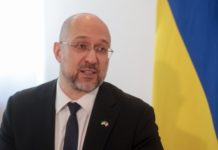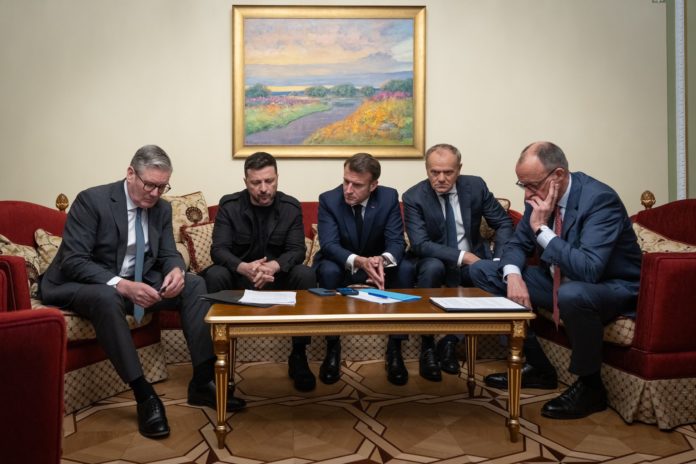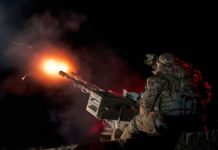As of May 10, 2025, the 1172nd day of Russia’s full-scale invasion of Ukraine was marked by an escalation of hostilities along the entire frontline, massive drone and air strikes, and growing international support for the Ukrainian army. The Armed Forces of Ukraine continue to hold the defense and deliver significant strikes on enemy command centers and logistics hubs. On the diplomatic front, engagement with partners regarding long-term security has intensified.
The key events of the day included: over 1,000 Russian attacks, massive bombardments in Kharkiv and Donetsk regions, Germany’s transfer of new air defense systems to Ukraine, a strike on a Russian oil depot in Bryansk, and a visit by Italy’s Prime Minister to Kyiv.
Frontline Situation
As of May 10, 2025, intense fighting continued across the entire frontline. A total of 196 combat engagements were recorded during the past day, with an additional 117 since midnight. The enemy carried out 36 airstrikes, dropped 51 guided bombs, launched 2,174 kamikaze drones, and used over 7,000 means of firepower, including 2,943 artillery barrages and multiple MLRS salvos.
The most active combat zones included:
- Kharkiv axis: At least six attacks were repelled in the areas of Vovchansk, Kamianka, and Mala Shapkivka. Shelling was recorded in Chuykivka, Maryine, Brusky, Ulanove, Yastrubshchyna, and Bila Bereza.
- Kupiansk axis: The enemy unsuccessfully attacked near Zahryzove.
- Lyman axis: Over 20 attacks took place near Ridkodub, Zelena Dolyna, Cherneshchyna, Olhivka, Novyi Mir, and Hrekivka.
- Siversk axis: Attacks targeted Bilohorivka, Hryhorivka, and Verkhniokamianske.
- Kramatorsk axis: Fighting occurred near Chasiv Yar, Bila Hora, Kurdiumivka, Orikhovo-Vasylivka, Predtechyne, and Mayske.
- Toretsk axis: At least 15 assaults were conducted near Toretsk, Dachne, Diliivka, Shcherbynivka, and Druzhba.
- Pokrovsk axis: A record 65 attacks were launched in the past day and 38 more during the current day, particularly near Promin, Yelyzavetivka, Kotlyne, Zvirove, Myrne, Preobrazhenka, Udachne, Novooleksandrivka, Lysivka, and Novomykolaivka.
- Novopavlivka axis: 31 attacks were reported near Bahatyr, Kostiantynopil, Rivnopil, Vilne Pole, Novopil, and Shevchenko.
- Huliaipole axis: Ukrainian forces repelled over 11 attacks near Novopil and Novosilky. Malynivka and Zaliznychne were hit by airstrikes.
- Orikhiv axis: Six assaults were stopped near Stepove, Novodanylivka, and Mali Shcherbaky.
- Dnipro River axis: Three unsuccessful Russian attempts to advance.
- Kursk axis: 19 assaults recorded, along with 156 artillery strikes and four airstrikes.
Ukrainian forces are effectively holding the line and inflicting heavy losses on the invaders.
Russian Losses
According to the Ukrainian General Staff, Russian forces suffered the following losses on May 10, 2025:
- Personnel: 1,310 troops (total since February 24, 2022 — approximately 964,580),
- Tanks: 4 (total — 10,790),
- Armored vehicles: 7 (total — 22,440),
- Artillery systems: 49 (total — 27,637),
- MLRS: no changes (total — 1,380),
- Air defense systems: 1 (total — 1,158),
- UAVs (operational-tactical): 36 (total — 35,482),
- Vehicles and fuel trucks: 106 (total — 47,830),
- Other equipment: no changes.
The sharp rise in artillery, drone, and vehicle losses indicates the effectiveness of Ukrainian strikes on enemy logistics and fire positions.
Ukrainian Achievements
On May 10, 2025, Ukraine’s Armed Forces carried out a series of successful operations against Russian forces:
- 1,310 Russian troops were eliminated;
- 4 tanks, 7 armored vehicles, 49 artillery systems, and 1 air defense system were destroyed;
- 36 drones and 106 vehicles were neutralized;
- The Ukrainian Air Force, artillery, and missile units struck:
- 7 enemy troop and equipment concentration points,
- 1 UAV command post,
- 3 artillery systems,
- 2 other key enemy assets.
These actions significantly weakened Russia’s offensive capabilities, especially around the Dnipro region, Pokrovsk, and Kursk axes.
Diplomatic Initiatives and Negotiations
On May 10, 2025, diplomatic efforts toward ending the war in Ukraine intensified. A major summit was held in Kyiv with top world leaders, alongside new ceasefire proposals involving the United States.
- French President Emmanuel Macron, German Chancellor Friedrich Merz, UK Prime Minister Keir Starmer, and Polish Prime Minister Donald Tusk arrived in Kyiv for talks with Ukrainian President Volodymyr Zelenskyy.
- A proposed unconditional 30-day ceasefire starting May 12 was supported by U.S. President Donald Trump.
- Russia expressed conditional interest in a ceasefire only if Western arms deliveries to Ukraine ceased.
- Ukraine rejected a symbolic three-day ceasefire offer (May 8–10), citing its link to Russia’s Victory Day parade.
- Turkey offered to send observers and reaffirmed its support for Ukraine’s territorial integrity.
- Kyiv hosted a “Coalition of the Willing” summit with representatives from 31 countries discussing post-war security and potential peacekeeping deployments.
These developments marked renewed international momentum toward a stable ceasefire and long-term peace.
International Support for Ukraine
May 10, 2025, saw multiple declarations of support for Ukraine from its allies across defense, humanitarian, and diplomatic domains:
- Germany ceased publishing details of its military aid shipments to Ukraine. Chancellor Friedrich Merz explained this move was aimed at hindering Russian analysis of logistical patterns.
- European leaders, backed by U.S. President Donald Trump, issued a joint ultimatum to Russia demanding acceptance of a 30-day ceasefire. Further sanctions were promised if Moscow refused.
- The UK extended its military training program for Ukrainian soldiers through 2025, focusing on drone warfare and urban combat.
- France delivered mobile field hospitals and counter-drone radar systems to safeguard Ukrainian infrastructure.
- Italy unveiled a new humanitarian aid package, including medical supplies, generators, and construction materials for liberated areas.
- NATO announced plans for a June summit in The Hague to define long-term security mechanisms for Ukraine.
These measures reinforce Ukraine’s defensive capacity and international diplomatic position.
Humanitarian Situation in Ukraine
On May 10, 2025, Russian shelling caused civilian casualties and damage to critical infrastructure across multiple regions. The worst-hit areas included Donetsk, Sumy, Kharkiv, Kherson, Mykolaiv, and Odesa.
- In Kharkiv, kamikaze drone attacks damaged a power facility. Most of the city was left without electricity for six hours before restoration.
- In Donetsk region, shelling in Pokrovsk district killed three civilians and injured eight. Residential buildings and transport infrastructure were also hit.
- In Sumy region, over 150 artillery strikes and 13 guided bomb drops targeted border villages in Bilopillia and Krasnopillia communities. A school and a medical center were destroyed, with injuries reported.
- In Kherson region, an evacuation point in Havrylivka village came under fire. Three volunteers were wounded.
- In Mykolaiv, falling debris from intercepted drones damaged water supply systems. Emergency reserves were activated.
- In Odesa region, air defenses shot down all 17 incoming Shahed drones. Debris damaged warehouses in the Izmail district.
- The UN Office for the Coordination of Humanitarian Affairs reported over 5.3 million internally displaced persons in Ukraine, mostly from Donetsk, Kharkiv, Luhansk, and Zaporizhzhia regions.
- Volunteer groups including Leleka, Caritas, and Vostok SOS delivered more than 12 tons of humanitarian aid to right-bank Kherson, including medicine, water, and hygiene supplies.
Despite the risks, Ukrainian relief workers and volunteers continue operating in front-line areas to support civilians and ensure access to essential services.
Domestic Situation in Ukraine
On May 10, 2025, Ukraine’s internal affairs remained stable despite ongoing war. Key topics of the day included mobilization policy, economic developments, public sentiment, and social reforms.
- The Verkhovna Rada extended martial law and general mobilization until August 7, 2025. Updated rules for reserving workers in strategic industries were also introduced to sustain defense production.
- The government approved an expanded mobilization deferment policy for men raising three or more children, including stepchildren, when no other relatives can provide care.
- The Ministry of Defense reported over 8,000 applicants to the new “Contract 18–24” service program, offering 12-month terms and a ₴1 million reward.
- According to OECD, Ukraine’s GDP growth is expected to slow to 2.7% in 2025, with inflation potentially reaching 13.2%. Defense spending exceeds 26% of GDP, but only ₴55 billion is allocated for weapons production.
- A KIIS poll found that 67% of Ukrainians trust President Volodymyr Zelenskyy, while 29% do not — one of the highest approval levels since the war began.
- The Razumkov Center reported rising emotional fatigue: 38% of respondents feel exhausted, 27% anxious, and only 9% say they feel well. Visits to family doctors and psychologists have increased.
- From May 1, 2025, utility tariffs remain frozen: gas — ₴7.96/m³, electricity — ₴4.32/kWh. The government pledged stability until October.
- Military cadet stipends were increased: ₴8,000 monthly, and ₴20,100 for top-performing senior cadets and trainees.
- The Ministry of Education announced basic military training will be introduced in vocational and higher education institutions starting September 1 for students aged 18–25.
Despite mounting challenges, Ukraine maintains its social obligations and domestic stability, reinforcing public morale and national resilience.
Conclusion
May 10, 2025, was marked by high-intensity conflict and strategic developments across all domains — military, diplomatic, humanitarian, and domestic. Ukrainian forces repelled more than 100 Russian attacks and delivered precise counterstrikes. Russian troops suffered significant losses, particularly in equipment, drones, and artillery, highlighting the effectiveness of Ukraine’s defense.
On the global stage, Ukraine received substantial support, including new aid packages and coordinated calls for a ceasefire. At home, the government continued to implement crucial social measures, mobilization policies, and economic stabilization plans — demonstrating its adaptability amid prolonged war. Although the humanitarian situation remains challenging, it is under control thanks to coordinated efforts by rescue teams, volunteers, and international partners.
Despite all challenges, Ukraine remains resilient, preserves its combat capacity, and enjoys strong public trust in its institutions. Strategic decisions and allied support lay the groundwork for strengthened resistance and eventual victory.
🤝 SUPPORT US 💙💛
We continue to work only because you read and support us. If you appreciate what we do, please become our sponsor or donate here👇
☑️ patreon.com/meanwhileinukraine
or
☕️ buymeacoffee.com/meaninuak
or
☕️ ko-fi.com/meanwhileinua
Your support helps us continue delivering timely and accurate updates. Stay informed and stand with Ukraine! 🇺🇦
Together we are stronger! 🇺🇦
























